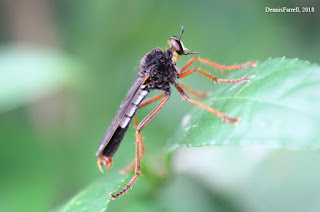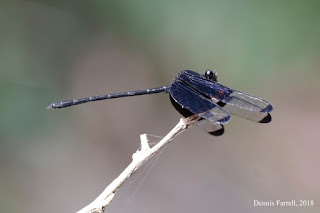Number: 208
Family: Philogangidae
Family: Philogangidae
Genus: Philoganga
Species: Philoganga loringae
Common name(s): N/A
Synonym(s): N/A
Habitat: Small forested stream
Province(s) sighted: Phu Khieo Wildlife Sanctuary, (Chaiyaphum)
Sightings (by me): 1 male
In flight (that I have seen): May
Species easily confused with: Philoganga montana
After years of searching during March and April at PK, I had mentally given up on seeing Philoganga loringae. I know it is on the wing during this time and it had also been recorded at Phu Khieo in March, though I am not sure how many years back we are talking. I never managed to see it and thought that it may not actually be there anymore. However, during a recent trip right at the end of May, I was standing on a bridge looking down at a small, narrow stream with Adrian Plant and my brother, Paul, and pondering whether or not to investigate it. Suddenly, I spotted a large damselfly in the distance at eye level perched on a twig that was high up above the stream. Armed only with my 180mm macro lens getting a photo would have been an impossibility -- well, I actually tried and I am too embarrassed to show the shots. However, with my brother around, he is always set up for birds with his 100-400mm lens. With this setup, it was possible to get in a few shots, though they are only record shots for now. That said, I was clicking my heels all the way home with this sighting. Once I had a record shot in the bag, I searched the stream below but didn't manage to spot a single specimen, which was made worse by the fact that the male was still perched high above my head (maybe I need to learn female damselfly mating sounds if there were ever such a thing haha).
I had actually seen and photographed Philoganga montana a few hundred kilometres north of Kanchanaburi a few years back in March and, though still rare, P. loringae seems to be a little more common but had evaded my lens until now. So, roll on next year when I can spend more time searching for this stunning damselfly... but will go in March/April again now I know where it is and there may be a few others to be seen.
The male
Only record shots, but good enough for an ID. One of the largest damsels in Thailand.
After years of searching during March and April at PK, I had mentally given up on seeing Philoganga loringae. I know it is on the wing during this time and it had also been recorded at Phu Khieo in March, though I am not sure how many years back we are talking. I never managed to see it and thought that it may not actually be there anymore. However, during a recent trip right at the end of May, I was standing on a bridge looking down at a small, narrow stream with Adrian Plant and my brother, Paul, and pondering whether or not to investigate it. Suddenly, I spotted a large damselfly in the distance at eye level perched on a twig that was high up above the stream. Armed only with my 180mm macro lens getting a photo would have been an impossibility -- well, I actually tried and I am too embarrassed to show the shots. However, with my brother around, he is always set up for birds with his 100-400mm lens. With this setup, it was possible to get in a few shots, though they are only record shots for now. That said, I was clicking my heels all the way home with this sighting. Once I had a record shot in the bag, I searched the stream below but didn't manage to spot a single specimen, which was made worse by the fact that the male was still perched high above my head (maybe I need to learn female damselfly mating sounds if there were ever such a thing haha).
I had actually seen and photographed Philoganga montana a few hundred kilometres north of Kanchanaburi a few years back in March and, though still rare, P. loringae seems to be a little more common but had evaded my lens until now. So, roll on next year when I can spend more time searching for this stunning damselfly... but will go in March/April again now I know where it is and there may be a few others to be seen.
The male
Only record shots, but good enough for an ID. One of the largest damsels in Thailand.



















































